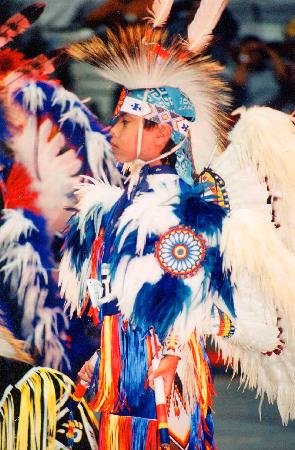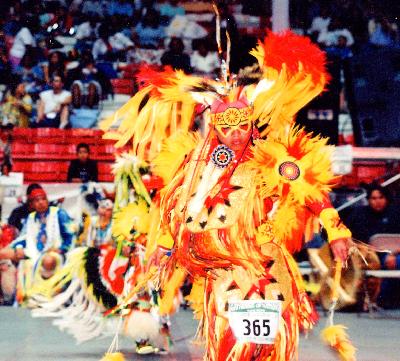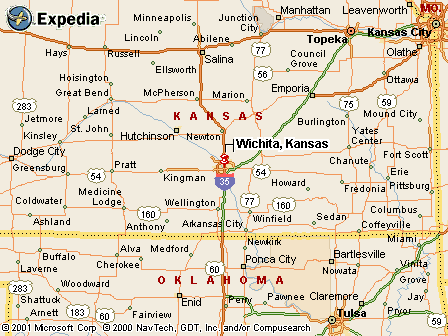|
|
Canku Ota |
|
|
(Many Paths) |
||
|
An Online Newsletter Celebrating Native America |
||
|
August 11, 2001 - Issue 42 |
||
|
|
||
|
Powwow Proud |
||
|
Powwows are about dancing, singing and learning -- but they're also about showing pride in who you are. |
||
|
by Rod Pocowatchit The Wichita Eagle-July 27, 2001 |
||
|
photos from Gathering of Nations by Suzanne Westerly |
 Wichita,
KS - Sidney Toppah Jr. is waiting to have his picture taken on a hot July evening. The 7-year-old is dressed in
his traditional regalia, known as the "fancy dance" style. The wind is blowing his feather bustles into
a frenzy of color, a brilliant green-and-white blur. Not far away, a little boy on a skateboard stops to take a
look, and gasps at Sidney's presence. But while some boys might duck their heads or retreat in embarrassment, Sidney
simply stands there. He has no reason to be ashamed. Wichita,
KS - Sidney Toppah Jr. is waiting to have his picture taken on a hot July evening. The 7-year-old is dressed in
his traditional regalia, known as the "fancy dance" style. The wind is blowing his feather bustles into
a frenzy of color, a brilliant green-and-white blur. Not far away, a little boy on a skateboard stops to take a
look, and gasps at Sidney's presence. But while some boys might duck their heads or retreat in embarrassment, Sidney
simply stands there. He has no reason to be ashamed.A member of the Kiowa tribe, Sidney started dancing at powwows when he was 2 years old. This weekend, he is being honored as the head little boy dancer for the 33rd annual Mid-America All-Indian Center Powwow, which begins today and continues through Sunday, at the Indian Center's powwow arena, 650 N. Seneca. The honor allows him to help lead the dances for the weekend, in company with adult dancers who will act as head man dancer and head lady dancer, as well as a head little girl dancer. They are honors not taken lightly in the powwow world, and Sidney's father wants his son to understand that. "I hope he learns that being honored like this is an important position," the elder Sidney Toppah said. "I want him to know that there are people out there watching him, how he conducts himself in the arena. That's very important to us. We try to teach him the right way." While powwows are lessons in life for some, they are also celebrations, a glimpse into Native American culture. Patrons at this weekend's powwow will get to experience native food, arts and crafts, as well as the vibrant singing and dancing. Vernon "Cy" Ahtone is the chairman for this year's powwow organization committee. He says the powwow is also a good chance for people to experience what the Indian Center has to offer, such as the Indian village exhibit. And in addition to the dance competitions that attract some of the best dancers in the region, patrons also will see a new category of competition this year. The drum contest will feature traditional singing groups competing for prizes. But powwows aren't all about spectacle. Ahtone said he thinks "a powwow is more than just a show. There's got to be feeling in it."  Some of that feeling comes from behind the scenes. For months, the committee has been planning
the event. All this week, crews were busy preparing the grounds in 100-degree weather. It seems a powwow isn't
just a time for people to dance together, but also for the city's Native American community to pull together for
a common cause. And most think nothing of donating the time and energy needed, Ahtone said. Some of that feeling comes from behind the scenes. For months, the committee has been planning
the event. All this week, crews were busy preparing the grounds in 100-degree weather. It seems a powwow isn't
just a time for people to dance together, but also for the city's Native American community to pull together for
a common cause. And most think nothing of donating the time and energy needed, Ahtone said."I personally, really do appreciate everyone's hard work. There's a lot of good people involved," he said. And that's what brings him back year after year, heading up the committee in a demanding, mostly thankless job. "Maybe this kind of life was just a part of me for so many years that I don't feel comfortable unless I'm around it, and have some kind of hands-on involvement. I've grown up around powwows, so I want to be involved as much as I can for as long as I can." Perhaps one day, Sidney Toppah Jr. will feel the same way. But for now, he will do what he knows how to do: dance. And his mother, Shawndae Toppah, will be there every step of the way. "I'm just proud of him," she said. |
|
|
|
Dance Styles |
|
|
||
|
|
||
| Canku Ota is a free Newsletter celebrating Native America, its traditions and accomplishments . We do not provide subscriber or visitor names to anyone. Some articles presented in Canku Ota may contain copyright material. We have received appropriate permissions for republishing any articles. Material appearing here is distributed without profit or monetary gain to those who have expressed an interest. This is in accordance with Title 17 U.S.C. section 107. | ||
|
Canku Ota is a copyright © 2000, 2001 of Vicki Lockard and Paul Barry. |
||
|
|
|
|
|
The "Canku Ota - A Newsletter Celebrating Native America" web site and its design is the |
||
|
Copyright © 1999, 2000, 2001 of Paul C. Barry. |
||
|
All Rights Reserved. |
||

